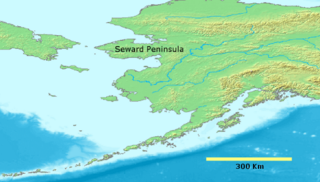Seward Peninsula

The Seward Peninsula is a large peninsula on the western coast of the U.S. state of Alaska. It projects about 320 kilometers (200 mi) into the Bering Sea between Norton Sound, the Bering Strait, the Chukchi Sea, and Kotzebue Sound, just below the Arctic Circle. The entire peninsula is about 330 kilometers (210 mi) long and 145 km (90 mi)-225 km (140 mi) wide. Like Seward, Alaska, it was named after William H. Seward, the United States Secretary of State who fought for the U.S. purchase of Alaska.
The Seward Peninsula is a remnant of the Bering land bridge, a roughly thousand mile wide swath of land connecting Siberia with mainland Alaska during the Pleistocene Ice Age. This land bridge aided in the migration of humans, as well as plant and animal species from Asia to North America. Archeological discoveries throughout the Seward Peninsula show proof that Inupiat Eskimos have been living in the region for thousands of years.[dubious – discuss] Excavations at sites such as the Trail Creek Caves and Cape Espenberg in the Bering Land Bridge National Preserve as well as Cape Denbigh to the south have provided insight into the timeline of prehistorical migrations from Asia to the Seward Peninsula.[1]
Demographics

Most of the peninsula is in the Nome Census Area, but part is in the Northwest Arctic Borough. These are the communities on the Seward Peninsula, with 2005 state population estimates:[2]
| City | Population |
|---|---|
| Nome | 3,508 |
| Shishmaref | 581 |
| Buckland | 434 |
| Koyuk | 350 |
| Brevig Mission | 327 |
| Elim | 302 |
| Teller | 263 |
| White Mountain | 224 |
| Wales | 151 |
| Golovin | 150 |
| Deering | 139 |
Other locations on the Seward Peninsula include the mining towns of Council, Solomon, Candle, Haycock and Taylor. While still frequented by locals of neighboring communities, there are no longer year round residents in these locations. There is a United States Coast Guard LORAN station at Port Clarence. The U.S. Air Force operates a radar station at the "Tin City" site, 7 miles (11 km) southeast of Wales.
Geography and ecology
The Seward Peninsula has several distinct geologic features. The Devil Mountain Lakes on the northern portion of the peninsula are the largest maar lakes in the world. They were formed over 21,000 years ago as the result of an underground steam explosion.[3] The Killeak Lakes and White Fish Lake are also volcanic maar lakes of notable size on the northern Seward Peninsula. Four mountain ranges line the southern side of the peninsula, the most prominent being the Kigluaik (or Sawtooth) Mountains. The highest point in the range and the peninsula is the peak of 4,714-foot (1,437 m) Mount Osborn. Other mountain ranges on the Seward Peninsula include the Bendeleben Mountains, Darby Mountains, and York Mountains. The Lost Jim Lava Flow north of Kuzitrin Lake is a lava field formed roughly 1,000 to 2,000 years ago, which covers roughly 88 square miles (228 km2). Several geothermal hot springs are located throughout the peninsula, including Serpentine Hot Springs, Pilgrim Hot Springs, Granite Mountain, Elim, Clear Creek and Lava Creek.
The Seward Peninsula has several rivers. The largest include the Koyuk, Kuzitrin, Niukluk, Fish, Tubuktilik, Kiwalik, Buckland and Agiupuk Rivers. These play a vital role in the subsistence lifestyles of many peninsula residents and ease travel, hunting, and fishing. Most peninsula rivers have at least a small yearly run of several varieties of salmon, as well as Dolly Varden, Arctic Grayling, whitefish of various species, Northern Pike, and Burbot. Most rivers on the Seward Peninsula freeze in mid-October; spring break-up usually occurs in mid- to late May.
The Seward Peninsula is the western-most limit of distribution for the Black spruce, Picea mariana, a dominant overstory species of the region.
Alaska's reindeer herding was concentrated on Seward Peninsula ever since the first shipment of reindeer were imported there from eastern Siberia in 1892.[4] It was believed that migrating caribou, could be prevented from mingling with the domesticated reindeer on the Peninsula because of the geography of the peninsula, thereby avoiding loss of reindeer that might wander off with caribou.[4][5] However, in 1997 the domesticated reindeer joined the Western Arctic Caribou Herd on their summer migration and disappeared.[6]
Cape Prince of Wales, the westernmost point on the mainland of the Americas, is on the western tip. The cape is only 51 miles (82 km) from Cape Dezhnev, the closest point on the Russian mainland. In August 2011 Russia announced an ambitious project to construct a rail tunnel under the Bering Strait, linking the Seward Peninsula in Alaska with the Chukchi Peninsula in Russia. If completed, the project would cost an estimated US $65 billion and would be the world's longest tunnel at 103 km (64 mi) long.[7]
The peninsula was named after William H. Seward, the United States Secretary of State who negotiated the Purchase of Alaska from Russia in 1867.
References
- ^ Cultural Resources in the Bering Land Bridge National Preserve
- ^ Alaska Community Database Community Information Summary
- ^ Rozell, Ned. Volcanoes, permafrost, earthquakes shape Alaska Alaska Science Forum.
- ^ a b Bucki, Carrie (2004), "Reindeer History in Alaska", Reindeer Roundup, Fairbanks, Alaska: Reindeer Research Program, retrieved 5 September 2014
- ^ "The Seward Peninsula". Fairbanks, Alaska: Natural Resources and Extension Program, University of Alaska. Retrieved 7 November 2010.
- ^ Querengesser, Tim (26 October 2009), "The Curse of the Deer", Maisonneuve.org, retrieved 19 April 2014
- ^ Halpin, Tony (2011-08-20). "Russia plans $65bn tunnel to America". The Sunday Times.
{{cite news}}:|access-date=requires|url=(help)

